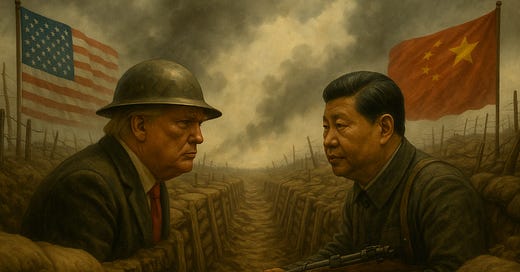The Trump administration is losing face and losing leverage. But for those hoping for a trade-war backpedal — don’t hold your breath.
The April 2nd Liberation Day announcement was an intentionally choreographed shock-and-awe affair that worked much better than many admit, at least at first. Swinging aggressively and recklessly, Trump caught everyone — trading partners and market watchers — on the backfoot, commanding global attention. This bad-cop routine also gave room for a good-cop retreat.
A 90-day pause announced on the eve of the “reciprocal” tariffs put a gleeful spin on what would otherwise be considered a paradigm-busting trade policy — a 10% tariff on most of the world, with limited exceptions. The administration has already implemented the highest and most wide-sweeping tariffs in a century, and these levies have been achieved without “retribution” by most countries, at least for now.
But such an aggressive first move has left its flanks vulnerable. While US vs. Everyone made for a dramatic opening sequence, the administration must now act out the Sisyphean script. After tossing the bird to every country in the world, can they sit across the table with these same folks and negotiate a hundred bilateral trade deals in just three months? Today is April 18th; Nine of the 90 days have elapsed with not one deal approaching completion.
Beyond simple bandwidth, there is the question of collective bargaining. Even if these negotiations are “bilateral” they don’t exist in a vacuum. In a one-vs-one matchup the US might hold the cards, but fighting every counterparty at the same time in such a public forum is an impossibly tall order, particularly with the China faceoff turning into a bare-knuckle brawl.
Perhaps most importantly, Trump hasn’t held the steely composure he donned in the Rose Garden. The stock market tantrum and volatility in Treasuries clearly changed the administration’s “take the medicine” tune. Meanwhile, the “Apple Exemptions” announced last weekend revealed inconsistency and pressure points. The soundbites coming from the White House are increasingly sounding clingy and desperate — Xi will call! Great progress with Japan!
The mojo has run dry. While Trump’s most steadfast followers weave narratives about strategy, most observers recognize dysfunction. If the plan was to encircle China, why alienate everyone else first? The shoot-first paradigm has created a situation where it’s not even clear that US negotiators have a specific objective, let alone a means to achieve it.
But the loss of the leverage does not mean the end of the trade-war. As time ticks with little progress on new deals (and a one-way tariff in place), the likelihood of retribution increases. Meanwhile, as Trump’s most aggressive ambitions falter, he will cling harder to the ground he has already gained. Even if there is some room for de-escalation with China, it seems more and more likely that the broad global situation is heading for a stalemate — a prolonged battle in which pain is felt on both sides while global trade suffers. Rather than a blitzkrieg with a swift and decisive outcome, the trade war is entering the trenches.




